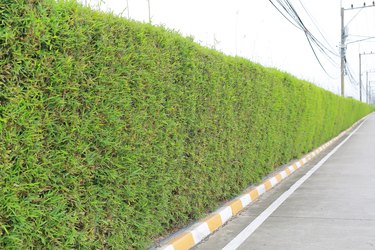
Bamboo grows very quickly, with some varieties growing 10 feet per year. This rapid growth makes bamboo an excellent choice when you want a natural fence and you want it quickly. Bamboo can be tricky, however, and you need to be careful which bamboo variety you plant and how. There are many invasive species of bamboo that are best avoided. Running bamboo varieties, too, can cause problems and are likely to end up in places you and your neighbors won't appreciate. It's actually against some local ordinances to grow bamboo, so check your area's regulations before planting.
Choose Your Type
Video of the Day
The first step to a bamboo fence is choosing what type of bamboo you'll plant. Bamboo plants are categorized as clumping or running. As the name suggests, clumping bamboo grows in thick patches, or clumps, forming a dense and bushy barrier. A clump is usually 3 to 10 feet around, depending on the bamboo variety. Clumping bamboo stays where you plant it, so you'll need a number of plants to create a barrier fence. Running bamboo quickly spreads itself, allowing you to grow a fence using fewer plants. Be aware, however, that running bamboo spreads indiscriminately. You'll need to take some extra steps during plating to keep it contained. If you don't, you and your neighbors will be battling unwanted shoots for a long time.
Video of the Day
Choose a Variety

Once you've decided on a clumping or running bamboo, take a trip to the garden center to choose your plants. Bamboo grows naturally on every continent except Antarctica, so you'll have no trouble finding a variety that grows in your climate. If you live in a colder area, consider cold-hardy species like red margin (Phyllostachys rubromarginata) and macon river cane (Arundinaria gigantea 'Macon'). Macon river cane is also excellent for poorly drained soils, where most bamboos don't do well. Bamboos generally prefer at least five hours of sun a day, but umbrella bamboo (Fargesia murielae) is an excellent choice for shady areas. Your local garden center is the best source of information about what types of bamboo will thrive in your area.
Plant Your Bamboo
Unless you've picked a variety that likes wet feet, plant your bamboo in moist, loamy soil. To plant your bamboo, dig a hole that is 1.5 to 2 times the size of the plant's root ball. Throw a handful of garden compost into the hole, and then gently place the bamboo plant into its new home. Back-fill the hole, aligning the soil so the plant is at the same depth it was in the nursery container. You will be able to see the old soil line on the plant. Tamp the dirt down gently as you go, to remove any air bubbles. For a fence, leave 3 to 5 feet between each plant. You can move the plants a bit closer together for a faster fence, but be sure you don't crowd your plants. Thoroughly water your new plants. Keep weeds away from young plants to reduce competition. Water your bamboo during dry spells, and thin the plants every two years by cutting back dead shoots at ground level. Apply a 10-10-10 fertilizer to the bamboo each spring.
Install a Barrier
If you've chosen and planted clumping bamboo, you're done. It's time to grab a beverage and hit the hammock. If you've planted running bamboo, however, you have another step to complete. You'll need to install a rhizome barrier to keep your bamboo from spreading into unwanted areas. To do so, dig a trench 3 feet deep on either side of your bamboo plantings. Place a rhizome barrier made of 40-millimeter high-density polypropylene in the trench, holding the seams together with strong glue or metal clamps. You can then back-fill your trench. If you prefer, fill your trench with concrete or bricks.